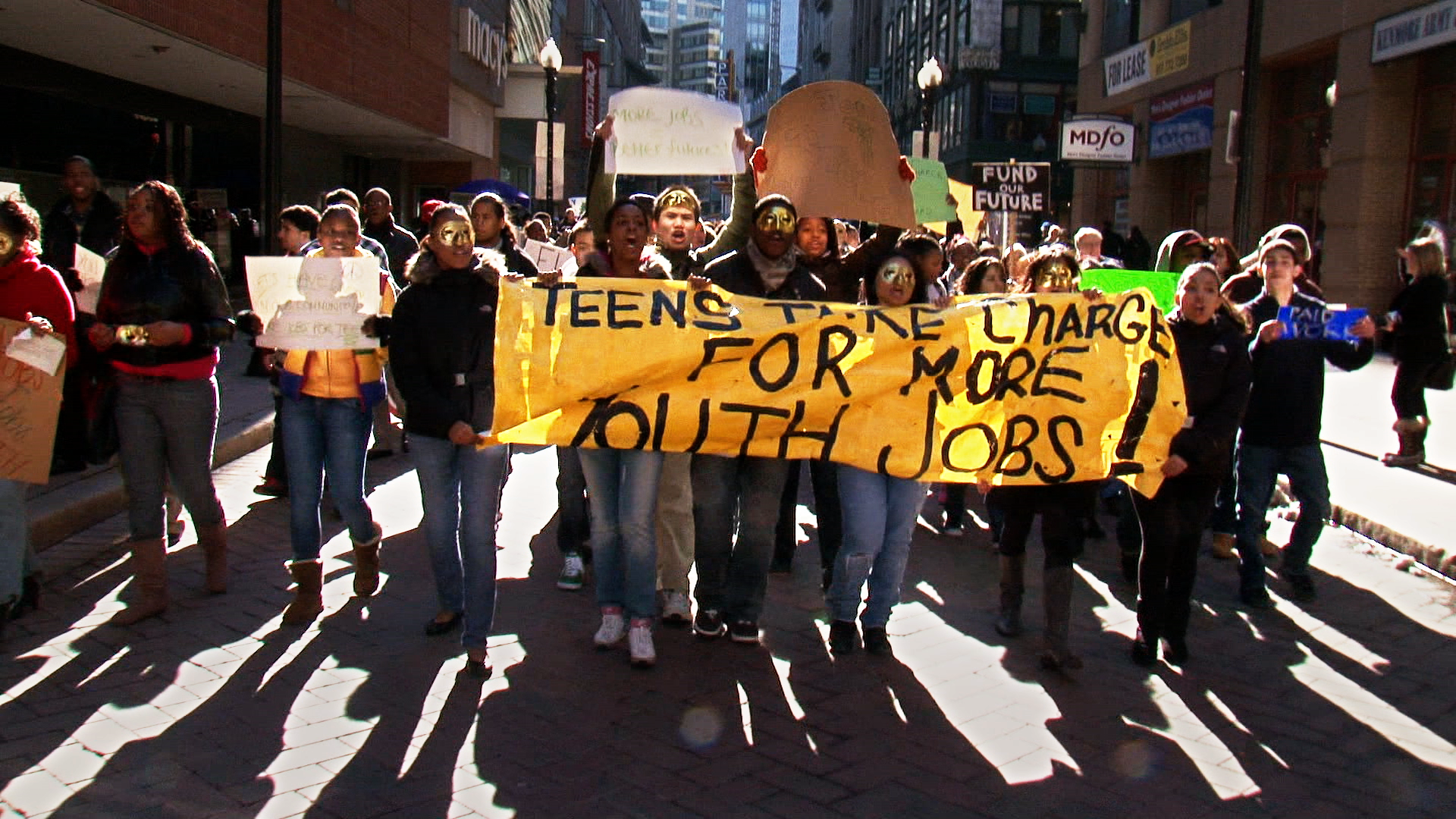About the Theme
“Nothing comes easy. That’s something we learned in this neighborhood a long time ago. If you want it, you’re going to have to work for it.”
Julio Henriquez

Conditions in a given neighborhood are affected by forces outside that neighborhood, from government at all levels to citywide and regionwide housing and job markets. DSNI is a place-based organization that focuses on a particular neighborhood, but recognizes these forces as well, having experienced the effects of both arson-for-profit and the foreclosure crisis, both driven by external forces. In the film, we see DSNI supporting youth members in lobbying for state funding for teen jobs, and board president Carlos Henriquez running for electoral office several times until he is finally successful. After the film was completed, then–executive director John Barros also made a run for mayor, and eventually became the city’s chief of economic development.
Questions for class discussion
- How does political/electoral engagement differ from community engagement?
- Given that it had limited resources to devote to it, how do you think DSNI made choices about which issues to engage in statewide advocacy on? How would you have chosen?
- What might be the challenges and benefits of a place-based group moving into advocating on issues that extend outside of its footprint? How about into electoral politics?
- How can and should broader issue advocacy relate to place-based work?
- DSNI is a nonprofit and can’t run candidates itself, but clearly participation in DSNI has encouraged some young people to make a move into politics. Why do you think some made that choice? What qualities of DSNI involvement prepared people who worked with it for public service? Can and should groups like DSNI make preparing community leaders for broader representation an explicit part of their goals, or is that a distraction from their mission? What about mobilizing the community to participate in the civic arena in a non-partisan manner? (e.g. civic education/voter mobilization)
- Then–Mayor Tom Menino is clearly a friend of DSNI’s. He recommends the Dudley neighborhood as the site for Boston’s Kroc Center, and later stands up for them in the fight over membership pricing at the center. He supports DSNI’s self-determination and unusual level of involvement in planning for their neighborhood. And yet Carlos talks in his Council run about their neighborhood getting disparate treatment, not getting the services it needs. What do you suppose are the processes at work creating that disparity? How can one measure “equity” in neighborhood services across neighborhoods?
Further Reading/Watching
“What Kind of Community Organizations, and for What Purpose?” By James DeFilippas, Robert Fisher, and Eric Shragge, Shelterforce.
http://www.shelterforce.org/article/1992/what_kind_of_community_organizations_and_for_what_purpose/
Breakthrough Communities: Sustainability and Justice in the Next American Metropolis, Edited by M. Paloma Pavel, 2009.
http://mitpress.mit.edu/books/breakthrough-communities
“Direct Action Governing,” by Matt Hersh, Shelterforce.
http://www.shelterforce.org/article/2888/direct_action_governing/
“Organizing Nationally to Win Locally: Faith Based Community Organizing’s New Frontier,” by Heidi Swarts, Shelterforce.
http://www.shelterforce.org/article/1868/organizing_nationally_to_win_locally_faith-based_community_organizings_new_/
“Not Afraid to Speak Up,” (profile of organizing work by Low Income Housing Institute in Seattle) by Miriam Axel-Lute, Shelterforce.
http://www.shelterforce.com/online/issues/116/LIHI.html
“Network Organizing: A Strategy for Building Community Engagement,” by William J. Traynor and Jessica Andors, Shelterforce.
http://www.nhi.org/online/issues/140/LCW.html
“Budgeting for Democracy: How one community is campaigning for greater resident control of public resources,” by Alma B. Couverthié and Marianna Leavy-Sperounis, Shelterforce, Summer 2006.
http://nhi.org/online/issues/146/budgetingfordemocracy.html
Seattle Neighborhood Planning: “Citizen Empowerment or Collective Daydreaming?”
By Karen Ceraso Shelterforce Nov/Dec 1999.
http://www.nhi.org/online/issues/108/seattle.html
“Planning Power,” by Winton Pitcoff, Shelterforce, Nov/Dec 1999.
http://www.nhi.org/online/issues/108/planning.html
“Shelterforce Interview: Jerry E. Abramson, Louisville Kentucky’s Progressive Mayor on Housing and Community Development,” by Harold Simon, Shelterforce, November/December 1994.
http://www.nhi.org/online/issues/78/abramson.html
Aspen Institute Roundtable on Community Change, Voices from the Field III: Lessons & Challenges from Two Decades of Community Change.
http://www.aspeninstitute.org/sites/default/files/content/images/rcc/VoicesfromtheFieldIII.pdf
Notes for Educators/Facilitators
- For more advanced students, consider placing the question of how a neighborhood organization engages politically beyond its boundaries in the context of the shift in attention among funders from neighborhoods to regions. How does that shift affect placed-based organizations and their work?
- If your students are from Massachusetts, some of them may remember the legal trouble that Henriquez encountered after his election and raise it. (See the viewer’s guide Post-Production Updates, People section for more.) For help in discussing the complicated intersection of race, gender, violence, and law enforcement see Beth Richie’s Arrested Justice.
film clips on political engagement
28:45-29:30 – Election Day 1
46:40-48:35 – Election Day, running again (and winning)
53:00 – Youth at State House with Carlos H.